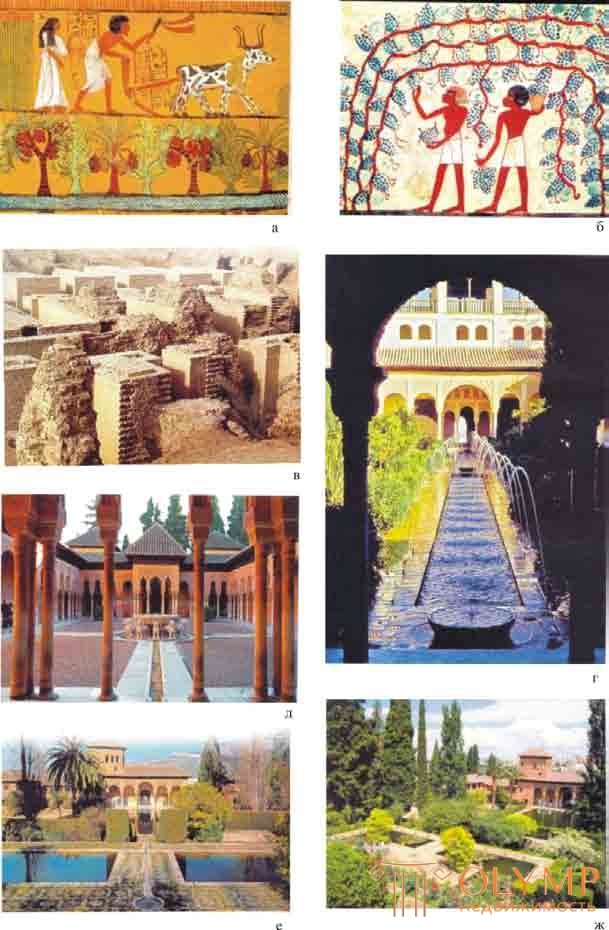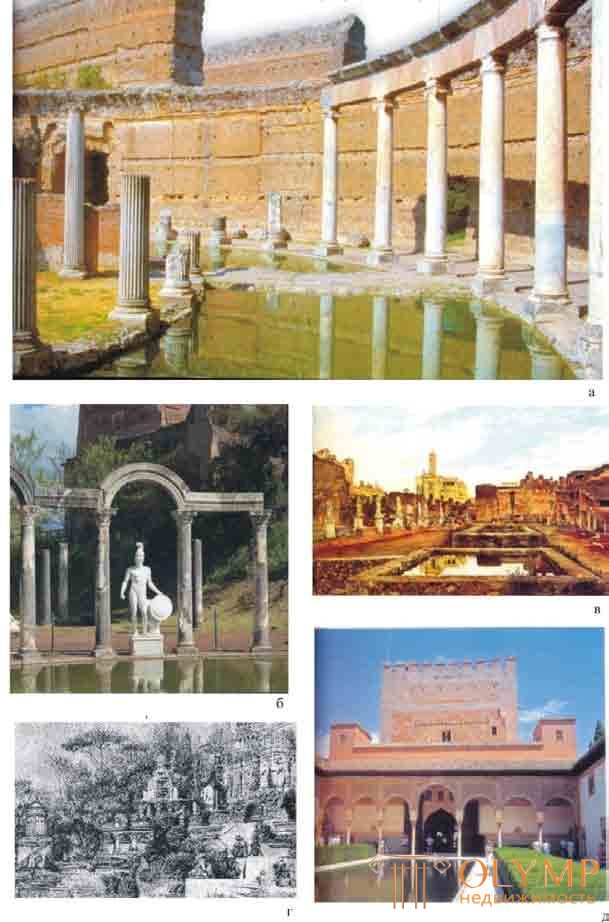
At the end of IV. The brilliant era of antiquity, with its sciences, art, architecture, ended its existence, giving way to a new era - feudalism. The period of time that numbers the millennium between the fall of Rome (the end of the 4th century) and the Renaissance in Italy (the 14th century) is called the Middle Ages, or the Middle Ages. The most prominent representatives of this period in landscape art are the gardens of Grenada, created in the 13th century, in the residences of the caliphs - the Alhambra (650 × 200 m) (Appendix, Fig. A 8) and Generalife (area 80 × 100 m) (Appendix, Fig. A 9).
In the Alhambra, the palace premises were grouped around the Myrtle Court (Appendix, Fig. B 1, f, g) and the Court of Lions (Appendix, Fig. B 1, e). Myrtle courtyard (Appendix, Fig. B 2, e) (47 × 33 m) is surrounded by walls of buildings with an elegant arcade, richly decorated with ornaments. In the center there is a pool (7 × 45 m), extended along a long axis and framed by rows of sheared myrtle. The main effect is the reflection of the arcade tower in the pool water. The courtyard of the lions (28 × 19 m) is also surrounded by walls and an arcade, crossed by two mutually perpendicular channels, in the center of which there is a fountain of two alabaster vases supported by 12 black marble lions.
There is also the Queen's Yard, decorated with a fountain, 4 cypresses in the corners, and most importantly - a complex ornament of the cover, into which the basin and cypress sites are woven.
The ensemble of Generalife (Appendix, Fig. B 1, d) is the summer residence of the caliphs, located 100 m above the Alhambra. It is a complex of isolated garden-patios on terraces. The most famous courtyard with a canal. It is elongated and surrounded by an arcade, a narrow 40-meter channel, decorated with two rows of fountains, is laid in the center. Their thin streams form an arched alley. Small trees and shrubs are freely planted in the garden.
In general, the traditions of the Spanish-Moorish garden are characterized by the following features: ease of planning and individuality of the solution. The layout is regular, due to the geometric plan of the patio. The garden has a compositional center, most often it is a swimming pool. The entrance to the garden is often located not in the center, but laterally, thereby breaking the symmetry, enriching the overall picture of the garden.
The connection between the inner enclosed space of the garden and the open exterior views is achieved by arranging specific points decorated with arcades. This method of interrelation has received further wide development in landscape art.
Water is the main motive of the garden. It is present in each patio in the form of channels, pools, springs, out of the ground. Water then flows down the canals made in the railing of the stairs, then a narrow strip penetrates the plane of the garden, then spreads out with an extensive mirror (Myrtle Yard), or forms fountain sprays. In all its diversity there is a desire to show the value of each of its drops.
Vegetation is used in such a way as to demonstrate the individual advantages of each specimen. Cypress, orange and tangerine trees, jasmine, almond, oleander, roses were planted freely. As an architectural element, haircut was rarely used.
The hot climate did not allow the use of a lawn, so most of the territory was decorated with decorative paving.
The color scheme is characterized by a combination of the overall restrained color range of walls, green trees and shrubs with bright patches of flowering plants or colored coatings. Decorative paving is one of the important elements of the Spanish-Moorish garden. Sometimes colored majolica revetted retaining walls and benches of the garden. Primary colors - blue, yellow, green.
Thus, the Spanish-Moorish style was formed with a complex of its techniques that meet the requirements of time, nature, and national traditions (Appendix, Fig. B 3, a, b, c, d). [10]

Fig. 1 a, b - paintings of the tomb in Egypt; in - the ruins of the hanging gardens. Babylon; Mr. - Generalife. Channel yard; d, e, f - the gardens of the Alhambra

Fig. 2 a, b - Villa Adriana. Rome; in - the temple of the goddess Vesta and the park. Rome; d - reconstruction of hanging gardens; d - Alhambra. Myrty courtyard
Что бы оставить комментарий войдите
Комментарии (0)